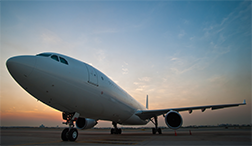First-Ever Aviation Emissions Standard Bolstered by Volpe Assessment
The international aviation community is on the cusp of certifying a first-ever carbon dioxide (CO2) emissions standard for commercial aircraft.
Experts on the International Civil Aviation Organization (ICAO) Committee on Aviation and Environmental Protection (CAEP) agreed in February to a CO2 standard that would apply to commercial aircraft types accounting for more than 92 percent of all aviation emissions.
“At Volpe, we conducted the environmental and economic modeling that informed this agreement on aircraft emissions,” said Gregg Fleming, director of Policy, Planning, and Environment at Volpe. “The U.S. modeling, conducted on behalf of the Federal Aviation Administration, was complemented by modeling from the European Union, which served as a second check on our results to make sure the CAEP had the best possible information available.”
Weighing 10 Scenarios for Emissions
The new technology-based standard was agreed to by CAEP’s 22 member states with support from over 170 international experts. With guidance from CAEP experts, the Volpe modelers assessed the cost effectiveness of 10 stringency options.
The stringency options, ranked 1 to 10, aimed to reduce aircraft CO2 emissions by integrating fuel efficient technologies into aircraft design and development. The Volpe assessment showed what would happen to CO2 emissions if an option took effect in different years, and demonstrated whether specific aircraft models would pass or fail the standard.
The final agreed-upon standard—nearly the most stringent option assessed—would apply to new aircraft as well as in-production aircraft.

“Even though it’s a CO2 standard, we not only looked at benefits associated with reduced CO2 emissions, we also looked at the palette of environmental tradeoffs,” Fleming said. “There are several interdependencies—we examined other pollutants, including noise. But the key driving factor is fuel burn.”
If the standard is accepted by the full ICAO body, Volpe modelers estimate that carbon pollution could fall by more than 650 million metric tons between 2020 and 2040—the same as removing more than 140 million cars from the road for a year.
The move would also reduce fuel burn by 4 percent by 2028, compared to 2015 aircraft models, and would produce monetary benefits.
Movement Toward International Adoption
The standard will move to the ICAO aviation governing council this summer, and will then be considered by the larger ICAO assembly. If approved, the standard will be binding for international air travel between the 191 ICAO member nations, beginning on January 1, 2020.
In the interim, each nation also has a unique process for implementing this new international standard into domestic regulations. Here in the U.S., both the Environmental Protection Agency and the Federal Aviation Administration (FAA) have the rulemaking responsibilities of establishing the new CO2 emissions levels and then enforcing the emissions level through aircraft certification, respectively.
To fully understand the suite of environmental benefits, Volpe modelers used the Aviation Environmental Design Tool (AEDT), which a Volpe-led team developed on behalf of the FAA. AEDT dynamically models aircraft weight and performance characteristics and weather conditions, and calculates the resulting noise, air quality, greenhouse gas emissions, and fuel burn.

